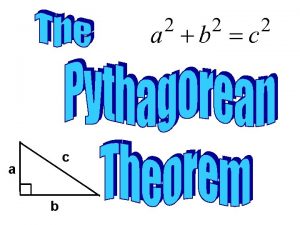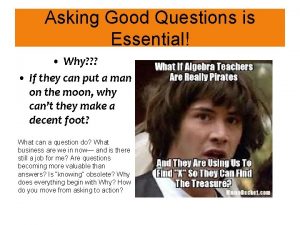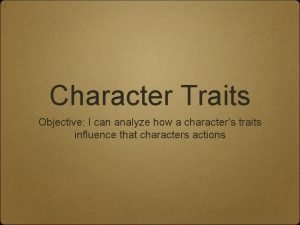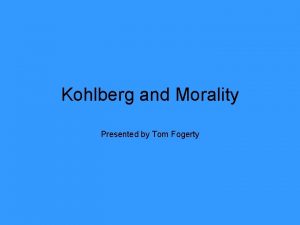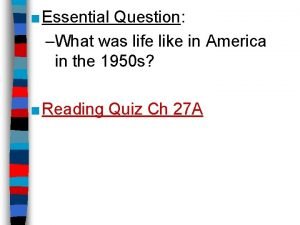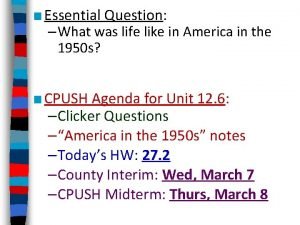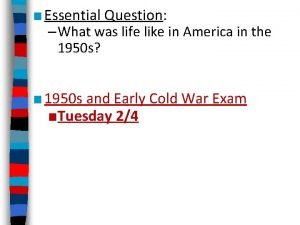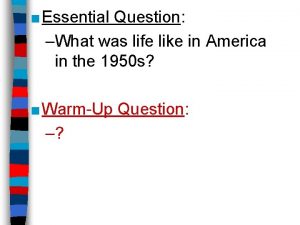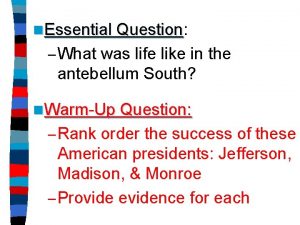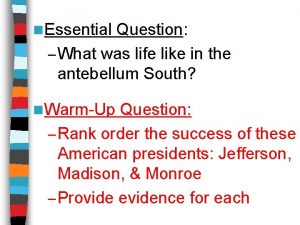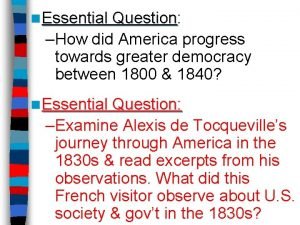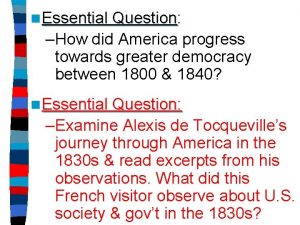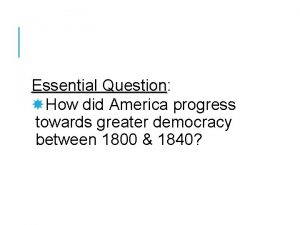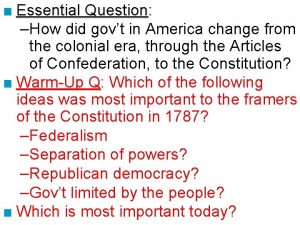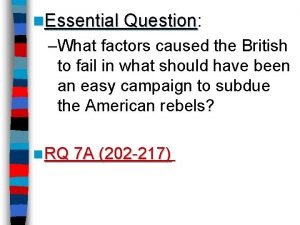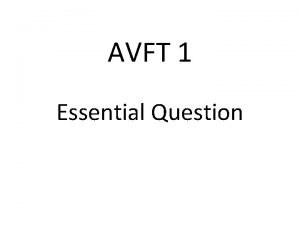Essential Question What was life like in America







































- Slides: 39

■ Essential Question: –What was life like in America in the 1950 s?

The 1950 s: The Affluent Society ■ The end of WWII led to an era of wealth & spending in the 1950 s: –The war stimulated the economy & ended the Great Depression –High wages, service pay for soldiers, & war bond investments gave Americans money to spend –The economic boom allowed Americans to enjoy the highest standard of living in the world

The 1950 s: Consumerism ■ Consumerism returned in the 1950 s –People rushed to buy new goods the&1 st time since the 1920 s, like. For TVs hi-fi record players Americans had access to cheap –Credit became available (The 1 st electrical appliances & cars credit card was created in 1950) –Advertisers used newspaper ads, radio, & new TV commercials to market goods to Americans –Franchises offered people across the country the same products

The “Affluent Society”

The 1950 s: The Baby Boom ■ Americans produced a “baby boom” in the 1950 s, leading to the largest generation in U. S. history –The return of soldiers from war led to an increase in marriages & a rise in the birthrate –The baby boom led to a demand for new baby products, schools, & homes for growing families

U. S. Birthrate, 1940 -1970 The late 1940 s & 1950 s experienced the “baby boom” In 1957, a baby was born every 7 seconds

The 1950 s: Suburbs ■ Suburbs boomed in the 1950 s: –The majority of Americans worked in cities but wanted the security of suburbs for their families –Suburbs offered peace of mind, affordable homes, & good schools –The GI Bill of Rights offered returning soldiers cheap loans for new homes & tuition for college


The desire for homes in the suburbs led to communities like Levittown in NY • massive 1 story high IN POPULATION • 12’x 19’SHIFTS living room DISTRIBUTION, • 2 bedrooms 1940 -1970 • tiled bathroom 1940 • garage Cities 31. 6% Suburbs 19. 5% • small backyard Rural Areas 48. 9% • front lawn 1950 32. 3% 23. 8% 43. 9% 1960 32. 6% 30. 7% 36. 7%

The 1950 s: Suburbs ■ Suburbs changed American life: –Suburbs increased America’s need for cars & highways –Churches, schools, grocery stores, & shopping centers were build to service the suburbs –But, the migration to the suburbs was mostly by white families; “White flight” to the suburbs left African Americans in urban areas

Southdale Shopping Center, Minnesota— the 1 st enclosed, air-conditioned shopping mall

The 1950 s: Automania ■ In the 1950 s, Americans bought cars in record numbers: –The growth of suburbs, creative advertising, easy credit, & cheap gasoline led to a car boom –Congress added 41, 000 miles of expressway when the Interstate Highway Act was passed in 1956 –Automobile companies made big, powerful, flashy cars



“Automania” transformed Americans were mobile, took long-distance vacations, & lived further from their jobs

“Automania” transformed America Cars led to drive-thru restaurants & drive-in movies

The 1950 s: Popular Culture ■ Americans in the 1950 s enjoyed new forms of entertainment: –Television boomed as Americans watched comedies, news reports, westerns, & variety shows –TV ownership jumped from 9% in 1950 to 90% by 1960 (45 million) –Businesses took advantage of TV to advertise goods to buyers

Television in the 1950 s TV Dinners

The 1950 s: Popular Culture ■ Music changed in the 1950 s: –“Doo-wop” music dominated the early 1950 s, but, was challenged in popularity by rock n’ roll –Rock ‘n’ roll music was inspired by black artists, but Elvis Presley made it popular among the youth –Rock scared parents who thought the fast beats were immoral


This rock ‘n’ roll music is a SIN!

Teenagers were an important force in the 1950 s Suburban teens had leisure time & money to spend

Teenagers were an important force in the 1950 s Businesses targeted teenagers, selling billions of dollars of “cool” consumer goods

Hollywood movies targeted teens & made films about “juvenile delinquency”

The 1950 s: Conformity ■ TV, movies, & advertising in the 1950 s promoted conformity & stereotypes The “ideal woman” was a housewife & mother

The 1950 s: Conformity ■ TV, movies, & advertising in the 1950 s promoted conformity & stereotypes The “ideal man” was provider & boss of the house

The 1950 s: Conformity ■ TV, movies, & advertising in the 1950 s promoted conformity & stereotypes Changing Sexual Behavior: Behavioral Rules of the 1950 s: § Sexologist Alfred Kinsey revealed § Obeythat: authority. § Premarital sex was § Control Your emotions. common § Fit in with affairs the crowd. § Extramarital were frequent among § Don’t even think about sex!!! married couples But, stereotypes were not accurate of most Americans

The 1950 s: Conformity ■ The “beat movement” rejected conformity: –“Beatniks” were artists & writers who lived non-conformist lives –Rejected suburbs, consumer goods, & “regular jobs” –Led by Jack Kerouac, the beats inspired the “hippies” of the 1960 s

Littlethe And they boxes people boys all on play gothe ininto on the hillside, the business, houses golf-course, Little All And went drink marry, boxes totheir the and made university, Martinis raise of ticky-tacky, a family, dry, Little Where And In boxes they made all on were have of theticky-tacky pretty put hillside, in boxes, children, Littlethey And the boxes, children came all look all the out go just same. all tothe school. same. And the There's there's achildren green pink doctors one goand to andsummer a lawyers agreen pink one camp And athen business bluetoone the executives, and university, a yellow one Where And they're they all aremade put inout boxes of ticky-tacky And they all come lookout just the same.

The 1950 s: Social Groups ■ The 1950 s had an important impact on women: –The media promoted women as mothers & homemakers, but almost 40% of mothers had jobs – 20% of suburban women reported being dissatisfied, isolated, bored –Working women were limited to nursing, teaching, clerical jobs

The 1950 s: Social Groups ■ African American civil rights leaders began to challenge segregation laws –In 1947, Jackie Robinson integrated professional baseball –In 1954, in Brown v Board of Education, the Supreme Court integrated public schools –In 1955, Martin Luther King, Jr. emerged as the leader of the civil rights movement

The Beginning of Civil Rights in the 1950 s

President Eisenhower’s Modern Republicanism

Eisenhower’s Modern Republicanism ■ Frustration with the stalemate in Korea & the Red Scare led to a Gov’t Korean War Communism Republican presidential takeover Corruption in the 1952 ■ WW 2 hero Dwight Eisenhower for “K 1 C 2” Onceprovided elected, Ikean didantidote go to Korea, overturned the U. N. battle plan, &Nixon threatened China with –VP Richard attacked nuclear war to get an armistice signed in 1953 communism & corruption –Eisenhower vowed to go to Korea & personally end the war

Eisenhower’s Modern Republicanism “I’m conservative when it comes to money ■ Eisenhower politics and liberal when itlabeled comes to his human beings” “Modern Republicanism”: –“Ike” believed in conservative gov’t spending & a balanced budget but he had no desire to end New Deal programs –The affluent, postwar “good life” at home was dependent upon a strong Cold War foreign policy

Eisenhower’s Modern Republicanism During the Eisenhower era, the U. S. economy avoided inflation & brought middle■ In spiraling his 8 years as president, Ike class a prosperity more Americans had modesttodomestic record: –Instead of ending New Deal programs, Eisenhower added to social security & minimum wage –Helped finance building & purchasing of suburban homes –Created the Depts of Health, Education, & Welfare –Interstate Highway Act of 1956 added 41, 000 miles of road

Eisenhower’s Modern Republicanism ■ Interstate Highway System: System –Highway Act of 1956 created 41, 000 miles of divided highway to connect major U. S. cities –These highways helped promote national defense, interstate trade, & vacation travel –All funds were raised exclusively through gas, tire, & car taxes

The Republicans “Have you no decency, Mr. Mc. Carthy? ” in Power ■ Regarding Mc. Carthyism, Ike provided Mc. Carthy “just enough rope to hang himself” in 1954 –In the televised “Army hearings, ” “I am not going to get into a [peeing] contest with a skunk” the nation saw Mc. Carthy’s style & fact-less attacks –The Senate censured Mc. Carthy & his “communist” attacks quickly died

 Level 1 2 3 questions
Level 1 2 3 questions Plamatic acid
Plamatic acid We can do a rap of the map of the us
We can do a rap of the map of the us Asia europe north america
Asia europe north america Whats an onomatopeia
Whats an onomatopeia Why is called latin america
Why is called latin america Happening e performance
Happening e performance Essential questions about figurative language
Essential questions about figurative language Formula hipotenusa triangle rectangle
Formula hipotenusa triangle rectangle Essential question generator
Essential question generator Essential questions for pythagorean theorem
Essential questions for pythagorean theorem Essential questions for figurative language
Essential questions for figurative language Individual vs society
Individual vs society Essential context clues
Essential context clues What is the essential question in cornell notes
What is the essential question in cornell notes What if questions to ask
What if questions to ask Essential questions for multiplication
Essential questions for multiplication Essential question gif
Essential question gif Essential questions for character traits
Essential questions for character traits What is the cornell way
What is the cornell way Short story essential questions
Short story essential questions 25 elements essential to life
25 elements essential to life Questions without question words
Questions without question words Highly closed question
Highly closed question Contoh open ended question adalah
Contoh open ended question adalah Examples of researchable and non researchable topics
Examples of researchable and non researchable topics Indirect questions expressions
Indirect questions expressions Examples of compelling questions
Examples of compelling questions Whats a compelling question
Whats a compelling question I would like to or too
I would like to or too Remo ualberta
Remo ualberta Which features of the sun look like huge cloudlike arches
Which features of the sun look like huge cloudlike arches Why does ethanol look like water but behave more like wood?
Why does ethanol look like water but behave more like wood? Like minds like mine
Like minds like mine What does he look like
What does he look like What does he look like
What does he look like I like the flowers
I like the flowers Language
Language Which is worse, stealing like karl or cheating like bob
Which is worse, stealing like karl or cheating like bob Like father like son in italian
Like father like son in italian










